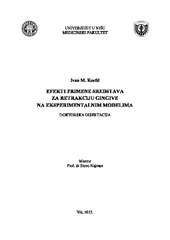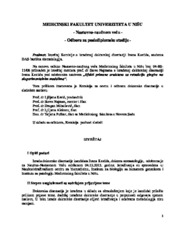Приказ основних података о дисертацији
Efekti primene sredstava za retrakciju gingive na eksperimentalnim modelima
| dc.contributor.advisor | Najman, Stevo | |
| dc.contributor.other | Kesić, Ljiljana | |
| dc.contributor.other | Mihailović, Dragan | |
| dc.creator | Kostić, Ivan M. | |
| dc.date.accessioned | 2016-03-20T17:05:28Z | |
| dc.date.available | 2016-03-20T17:05:28Z | |
| dc.date.available | 2020-07-03T16:06:57Z | |
| dc.date.issued | 2015-05-14 | |
| dc.identifier.uri | https://nardus.mpn.gov.rs/handle/123456789/4987 | |
| dc.identifier.uri | http://eteze.ni.ac.rs/application/showtheses?thesesId=2515 | |
| dc.identifier.uri | https://fedorani.ni.ac.rs/fedora/get/o:1026/bdef:Content/download | |
| dc.identifier.uri | http://vbs.rs/scripts/cobiss?command=DISPLAY&base=70052&RID=1025259757 | |
| dc.description.abstract | When creating fixed prosthetic devices it is necessary to respect the integrity of the periodontal structures and ensure maximum possible accuracy at the junction site of artificial crown and biological tissue. When the preparation border area is situated at the level or below the gingival margin, demarcation line should be made by reversible temporary shift in apical direction to enable access of impression material. The most commonly used gingival retraction agents are astringents (metal salts) and vasoconstrictors (adrenalin). They are applied in the gingival sulcus of prepared tooth, thus dilating and drying it out and creating optimal conditions for impression taking in indirect dental restoration. Given that the retraction agents are in direct contact with the gingival tissue their biocompatibility is of primary importance. Biocompatibility of dental materials implies the capability of performing a specific function in the oral cavity without causing side effects. However, it was established that the retraction agents might have iatrogenic effect on gingival tissue, especially if the patient had already had periodontal disease or was prone to such problems. The use of adrenalin may cause systemic reactions of the organism. The study was based on the assumption that commercially available gingival retraction agents exhibit some toxic effect on the surrounding tissues, and the degree of damage varies depending on the type, concentration and the effect duration. Biologically acceptable gingival retraction agents based on aluminum chloride and adrenalin should be sought among sympathomimetic vasoconstrictors (tetrahydrozoline). The aim of the study was comparison analysis of potentially toxic effects of gingival retraction agents and tetrahydrozoline in vitro and in vivo conditions. The tested material included three agents used for gingival retraction in dental practice: two materials based on aluminum chloride (10% and 25% solution), 8% adrenalin and 0.05% tetrahydrozoline solution. Biocompatibility of gingival retraction agents was examined under in vitro conditions on MDCK (Madin-Darby canine kidney) continuous cell line and under in vivo conditions on experimental animals. MDCK cells may be considered analogous to gingival epithelial cells, and the structure of gingival tissue and the depth of gingival sulcus of the rabbit is almost identical to that in humans. The effect of retraction agents and tetrahydrozoline on the viability and recovery of MDCK cell line was observed using vital staining with trypan blue and non-standard MTT assay. The solutions of the examined retraction materials obtained by dilution in Ringer solution in 5%, 10%, 25% and 50% concentrations were used. Measurements of the intensity of MTT reduction were performed immediately after a three, six and ten minute effect period of materials to determine the viability, or after a period of one day of cell recovery in a nutritious medium to determine the degree of recovery of cells. The values obtained in in vitro conditions represented the basis for the statistical analysis and were analyzed by SPSS 15.0. The analysis of variance (ANOVA) was used followed by Post-Hoc analysis, and the levels of p <0.05 were considered statistically significant. Quantitative changes in cell viability were presented descriptively as well. In vivo research included the effect of retraction agents and tetrahydrozoline on gingival tissue of experimental rabbits. The procedure and the seven minute application period were identical to clinical setting. The negative control (absence of intervention) and a false treatment (application of retraction floss without test agent) were predicted. The biopsy of gingival tissues and control was carried out after the observational period of one hour, one, seven and thirty days. The preparations were stained by means of traditional method – Hematoxylin & Eosin and analyzed histologically. The distribution of collagen fibers was determined under polarizing light. Evaluation of the results was performed semiquantitatively, based on the presence of inflammatory reaction and fibrosis tissue, as well as destructive-necrotic changes In an in vitro study the hypothesis was proved that the viability and recovery of the cell culture depended on the concentrations of the examined solution, the effect duration, as well as the type of the applied material. As the concentration and duration of action of the tested solutions of gingival retraction agents increased the cell viability statistically significantly decreased, indicating the potential toxicity of tested materials. Solutions of commercially available retraction agents proved to have no cytotoxic or slightly cytotoxic effect at the lowest concentrations (5% and 10%) and upon the observational period of three and six minutes. On the other hand, serious cytotoxic effect was observed after a ten-minute period at higher solution concentrations (25% and 50%) based on aluminum chloride. The results of the study proved the lowest cytotoxic effect of alternative gingival retraction agents based on tetrahydrozoline. In this type of material, decline of cell viability with an increase of effect duration and solution concentration was noticed as well. Comparison analysis showed statistically significant higher values of intensity reduction of MTT immediately after effects of retraction agents compared to the results obtained after the cell recovery. Taking into account the fact that cytotoxic effect of tetrahydrozoline was low, the results of cell recovery in culture were expectedly positive. In contrast, significantly higher values of cell viability immediately after the effects of commercial agents in relation to the values after further incubation of cells indicated the prolonged harmful effects of aluminum chloride and the possibility of initiating a secondary inflammatory response. The results of in vivo research pointed to the reversible damage of gingival tissue after local application of materials based on aluminum chloride and adrenalin. An hour after the removal no significant changes in the tissue structure were found. However, their use resulted in an acute inflammatory response after the observation period of one and seven days. After thirty days reparation of the damaged tissue was observed. Inflammatory changes due to tetrahydrozoline application were of significantly lower intensity compared to aluminum chloride and adrenalin and resulted in advanced healing after seven day obsevation period and full tissue reparation tissue after thirty day observation period. Tetrahydrozoline proved to be biologically more acceptable in relation to the retraction agents tested. The preparation based on tetrahydrozoline showed a higher degree of biocompatibility in vitro and in vivo conditions, and is therefore recommended for everyday use in dental practice. In order to prevent damage to the gingival tissue it is necessary to decrease the concentration of the agent used for gingival retraction by rinsing gingival sulcus with saline or water spray, reduce the duration of the retraction procedure to three to six minutes, as well as controlled teeth preparing with minimal tissue damage. | en |
| dc.format | application/pdf | |
| dc.language | sr | |
| dc.publisher | Универзитет у Нишу, Медицински факултет | sr |
| dc.rights | openAccess | en |
| dc.rights.uri | https://creativecommons.org/licenses/by-nc/4.0/ | |
| dc.source | Универзитет у Нишу | sr |
| dc.subject | gingiva | sr |
| dc.subject | gingiva | en |
| dc.subject | retrakciona procedura | sr |
| dc.subject | aluminijum hlorid | sr |
| dc.subject | adrenalin | sr |
| dc.subject | tetrahidrozolin | sr |
| dc.subject | retraction procedure | en |
| dc.subject | aluminijum chloride | en |
| dc.subject | adrenalin | en |
| dc.subject | tetrahydrozolin | en |
| dc.title | Efekti primene sredstava za retrakciju gingive na eksperimentalnim modelima | sr |
| dc.type | doctoralThesis | en |
| dc.rights.license | BY-NC | |
| dcterms.abstract | Најман, Стево; Кесић, Љиљана; Михаиловић, Драган 1954-; Костић, Иван М.; Ефекти примене средстава за ретракцију гингиве на експерименталним моделима; Ефекти примене средстава за ретракцију гингиве на експерименталним моделима; | |
| dc.identifier.fulltext | https://nardus.mpn.gov.rs/bitstream/id/53075/Disertacija619.pdf | |
| dc.identifier.fulltext | https://nardus.mpn.gov.rs/bitstream/id/53076/Kostic_Ivan_M.pdf | |
| dc.identifier.fulltext | http://nardus.mpn.gov.rs/bitstream/id/53075/Disertacija619.pdf | |
| dc.identifier.fulltext | http://nardus.mpn.gov.rs/bitstream/id/53076/Kostic_Ivan_M.pdf | |
| dc.identifier.rcub | https://hdl.handle.net/21.15107/rcub_nardus_4987 |



